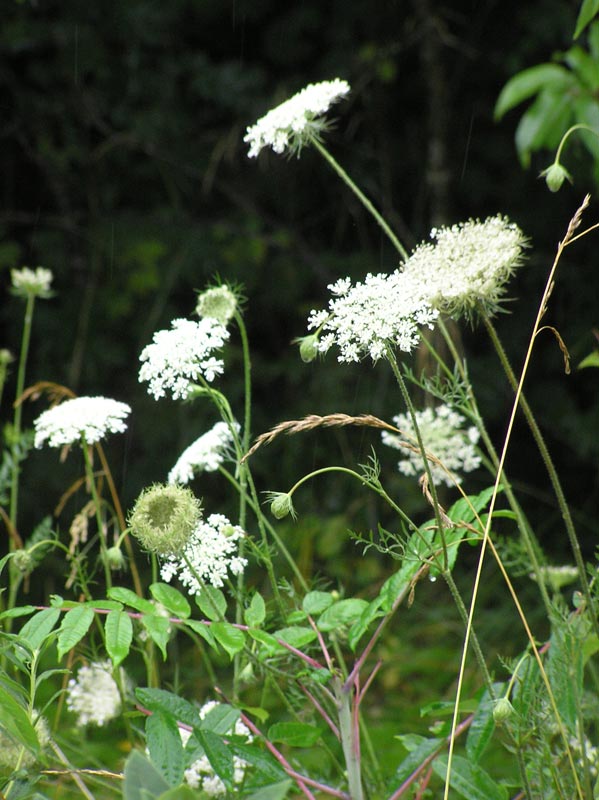The wild white flowers of early summer

Queen Anne’s Lace, a “wild carrot.†Photo by Ken Moore
By Ken Moore
Flora Columnist
They began flowering weeks ago and they are still making a show along roadsides and wherever folks allow them to move about freely on their lawns and in their gardens.
I learned to recognize the green winter leafy rosettes of Daisy Fleabane (Erigeron annuus) some years ago and I deliberately give them freedom wherever they appear in my wild landscape. My reward is masses of tiny white daisy flowers on multi-branching stems, three to five feet tall, cheering up my yard and garden areas for weeks and weeks. And this year, for whatever reason, they seem to be flowering in profusion everywhere, inspite of the continuing drought.
Our pioneer forebears considered this wildflower an insect repellant, thus the rather unappealing name, Fleabane. I don’t think we can depend on this today; however, I will attest to the fact that where the Fleabane is allowed to grow and flourish, the effect is the exuberance of an English cottage garden. In addition, this common Fleabane is a fantastic cut flower, being a showy companion with any garden plant or wildflower.
Another showy white flower is Queen Anne’s lace (Daucus carota), the “wild carrot†from which is derived our cultivated carrot. Following its introduction by European settlers centuries ago, it so quickly became a common weed that we have a rich heritage of food and medicinal uses for it introduced by Native Americans.
It is now regarded as a serious exotic invasive in some parts of our nation, particularly in the Midwestern prairie restorations, but it doesn’t seem to pose a real problem in our local Piedmont. It is such a beautiful work of art that I am always careful with the groups of them scattered about my wild landscape, and they are a great contrast mixed in with daylilies. Like the Fleabane, it’s not going to stay in place, but will move about wherever seed can find a foothold on a bare patch of soil.
Bearing pancake-size Queen Anne’s lace-like flowers is the Elderberry (Sambucus canadensis), a multi-stemmed shrub found in ditches and along pond edges. Unless you have such a permanently wet area, Elderberry is not going to volunteer for you, but plants are available at local native-plant nurseries, and you’ll cherish a planted specimen in a roomy, sunny spot in your landscape.
Goldfinches are attracted to the seed heads of the Fleabane and you’ll have to be really fast and persistent to get enough Elderberries for a jam or a pie, because the local mockingbirds will most likely beat you to them.
So how do you know you have one of these free plants in your yard? Well, recognizing the carrot-like foliage of the Queen Anne’s lace in the late summer and winter is rather simple. Recognizing the winter rosettes of Fleabane is a bit more difficult; to the unaccustomed eye, the leaves simply look like all other green leaves. The certain way to learn to recognize a volunteer plant in your landscape is to allow it to grow until it flowers. Then you’ll know what you have and whether or not it’s a keeper.
Many beautiful flowers are routinely “weeded†from our gardens because we simply don’t know what we have, and we assume that what we don’t know is bad.
Correction
Dan Stern, Botanical Garden curator of the Coker Arboretum, made me aware of my grievous error last week in naming the native wisteria. Our American Wisteria is W. frutescens, not W. floribunda. The commonly planted Japanese Wisteria, (W. floribunda) and the Chinese Wisteria, (W. sinensis), both Asiatic imports, will aggressively escape, climb, girdle and kill trees. Please destroy them and plant only our native W. frutescens.
Many thanks Dan, and to all, your watchful and critical attention to Flora articles is very much welcomed.
Email Ken Moore at flora@carrborocitizen.com.


Comments are closed.